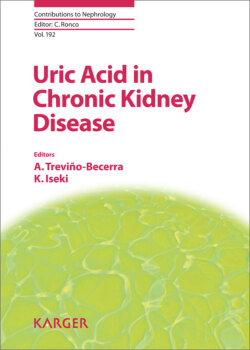Читать книгу Uric Acid in Chronic Kidney Disease - Группа авторов - Страница 12
На сайте Литреса книга снята с продажи.
Introduction
ОглавлениеUric acid is a heterocyclic compound (2,6,8-trihydroxypurine [C5H4N4O3]) and its diprotic acid characteristics include 2 dissociable protons with pKa1 ≈5.4 and pKa2 ≈10.3. At physiological human pH, the breakdown of uric acid occurs in 99%, forming acid urate ion in the extracellular fluid, mainly in its circulating form [1, 2].
In a constant neutral blood pH, the index between urate ion and uric acid remains stable and the average concentration of urate levels is close to the solubility limit (6.8 mg/dL). Both terms refer to the total uric acid value (dissociated and undissociated forms) [2]. Even though uric acid excretion happens through the kidneys, the urinary point of neutrality on the pH scale ranges from 4.6 to 8.0 but varies much more in lower urinary pH, increasing in greater proportion its undissociated form because of its poor solubility in aqueous solution [2].
